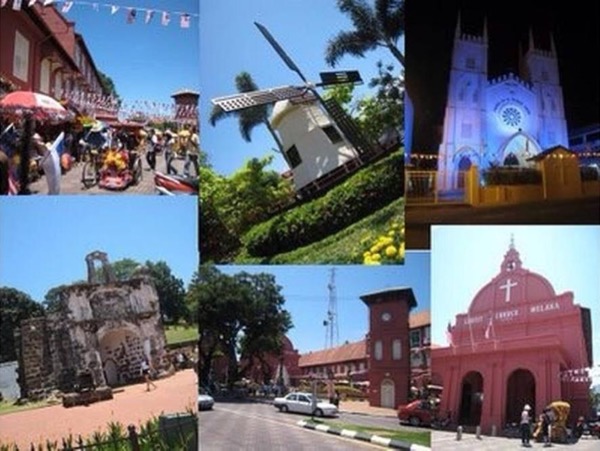Looking around: Tourists soaking in the sights in Jalan Tun Tan Cheng Lock.
JONKER Street, or Jalan Hang Jebat, is possibly the most famous road in Malacca, thanks to Jonker Walk which attracts hordes of tourists from all over the world.
But the road running parallel to it – Heeren Street – has a more interesting history and richer architectural charms.
Heeren Street, or Jalan Tun Tan Cheng Lock, was once the place to live for those who made it to the top.
Originally called “Kampung Belanda” (Dutch Village), it ended up with the nickname of “Millionaires’ Row” because of its well-heeled residents.
The narrow street with houses adorned with ornately decorated façades was the choice neighbourhood for the prosperous Straits-born Chinese (Peranakan or Babas and Nyonyas) in the mid-19th and early 20th century.
These affluent folks competed with each other to build the most flamboyant of houses, many of which stand to this day.
Quite a number have been fully restored to their former glory and turned into highly popular boutique hotels, museums, galleries, restaurants and cafes.
Walking into these places is like going back in time to the era of Malacca’s occupation by the Dutch.
A classic example to visit is Number 8, Jalan Tun Tan Cheng Lock, a shophouse built in the 1700s.
It has been painstakingly renovated by Badan Warisan (Malaysia’s National Trust) with a grant from the US Embassy.
Entry is free but donations are welcome.
The grandest of them all: The Chee Mansion was built by the first chairman of the OCBC.
While Jonker Street (from the Dutch Jonghheer) was named after a place for “young noblemen” who had not quite made it to the upper level of nobility.
Heeren Street (originally Heeren straat), was for the “gentlemen” or “masters” in the upper crust of society.
The characteristic features of most buildings are high roofs, floors and corridors lined with intricate tiles, teak front doors carved with family names or mottos in gold calligraphy.
Most windows are also beautifully decorated with motifs while some homes even have decorated roofs with image of dragons, birds and flowers.
The houses on the street are rather narrow and small when viewed from the outside but are long and spacious inside.
This is because the houseowners then were taxed on the width of the buildings instead of the total area.
Most of them have open courtyards to provide ventilation and light. Some even have small wells to draw water or ponds to collect rainwater from the roof.
The street was home to famous Malacca Babas, including Tan Kim Seng, one of the pioneers in the development of Singapore, and Tan Chay Yan, who was Malaya’s first rubber planter in 1896.
Tan Kim Seng or Baba Kim Seng, who amassed a great fortune in Singapore, built a bridge across the Singapore River which is now named after him.
He also donated money for a bridge, named after him in Malacca, and for the famous Clocktower in front of Christ Church in the Dutch Square.
Tan Kim Seng’s stately ancestral home, built in 1822, is the present Hotel Puri.
When it was the home of Kim Seng, there was a menagerie behind with many animals, including a tiger.
The grandest house in “Millionaires’ Row” is the Chee Mansion, which stands majestically directly opposite Hotel Puri.
The breathtaking building is a Dutch era architectural gem, complete with a fairy-tale inspired watchtower.
It was built by tycoon and philanthropist Chee Swee Cheng, the first chairman of the Overseas Chinese Banking Corporation (OCBC).
As it was run almost entirely by the Baba’s in the old days, OCBC was jokingly referred to as Orang China Bukan China.
Chee Swee Cheng built the mansion at 117 Heeren Street as a dedication to his father, Chee Yam Chuan.
The Chee Mansion, also known as the Chee Yam Chuan Temple, is used as the family’s ancestral home.
But “Millionaires’ Row” bears the name of an outstanding fifth-generation Baba and one of the country’s illustrious early leaders.
Tun Tan Cheng Lock, who co-founded the MCA in 1949, was born at house number 111.
The dignified family home was where the country’s first Prime Minister Tunku Abdul Rahman and Tan held many discussions before Merdeka.
His son, Tun Tan Siew Sin, was Malaya’s first Commerce and Indus try Minister before being the longest serving Finance Minister for 15 years.
He was also the third president of the MCA after his father and Tun Dr Lim Chong Eu.
It may not be as hectic as Jonker Street where the tourists to Malacca throng but Heeren Street oozes more history, old-world charm and provides amazing sights and stories.

No comments:
Post a Comment